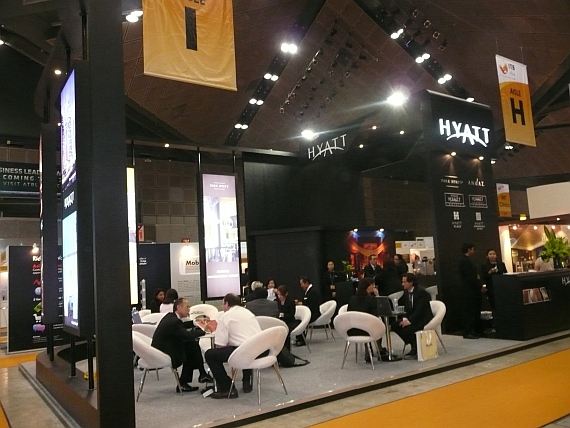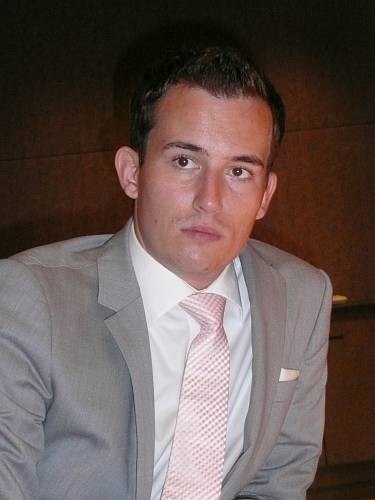3rd ITB Asia: trade fair shows extremes and opportunities in the mega market
 |
|
| Hyatt Hotels - a repeating exhibitor in Singapore. The hotel industry is ITB Asia''s biggest supporter. |
Singapore (October 29, 2010). After a six-percent increase in the number of exhibitors, the 3rd ITB Asia closed with a plus of visitor numbers too: This year, there were 6,606 visitors - 7.4% more than the previous year. These figures show that the ITB Asia in Singapore is slowly being accepted as a travel trade fair in the Far East. This year''s additional programmes – the expert panels – seemed to be in touch with the times with the new mixture. The B2B trade fair is growing; however, it is still small compared to the ITB Berlin and therefore it is quite easy to become familiar with the trends in Asia very quickly. At the luxury meetings there are similar trends recognisable but glaring differences in technology trends. In the Asian mega market, where many touristic and business areas have not been developed yet, speed is dominating and not quality.
Three years after the launch, the organiser, Messe Berlin (Singapore), is delighted about the new dynamics in the trade fair segment: the mixture of expert panels, the attractive outbound demand in Asia, and more quality among the purchasers were the driving forces for the 3rd ITB Asia, which took place from Wednesday to Friday last week in Singapore. This has already led to first early bookings: "We already have a great number of ''Early Birds'' for the ITB Asia 2011," reported Nino Gruettke, ITB Asia Executive Director, at the end of the trade fair. For next year, he also announced a new branding for the ITB Asia.
The trade fair operator was already in the black with the 3rd ITB Asia, explained Dr. Martin Buck, Head of ITB Berlin to German journalists in Singapore – even without the initial subsidies of the city of Singapore. "However, our learning curve is still steep in Asia," he put his statement into perspective: every year, the trade fair tried out something new, in order to come closer to the exhibitors'' and (hosted) buyers'' expectations. For example, the ratio of European and Asian purchasers had to be adjusted and the quality of the purchasers had to be increased (see link). And globally renowned names were partly still missing among the exhibitors - e.g. providers such as Amexco in the business travel segment.
Nevertheless, the ITB Asia is one of the largest travel trade fairs in Asia, says Buck: it is two times larger than the PATA Travel Market, which permanently changes location and only has half the number of exhibitors, despite its longer history; the much smaller IT&CMA Bangkok and the CJTM in China, alternating between Shanghai and Guangzhou, rate among them as well.
|
ITB ASIA 2010 Closing Report |
|
"Our concept is Outgoing," says Buck, "the ITB Asia is an Outgoing trade fair. This is the difference to other trade fairs." In Singapore, business travels and MICE are the core subjects; in Berlin, touristic travels predominate.
The hotel industry backs up the trade fair
As the trade fair newcomer was able to survive the 2009 crisis year and was even able to increase its figures, a continuing upswing is expected. Nino Gruettke expects an annual growth rate of eight to ten percent – "without external shocks", such as the financial crisis. Last week, there were about 100 hotels or hotel groups among the exhibitors; some of them are already exhibiting in Berlin and Singapore.
Among this year''s new exhibitors in Singapore were Small Luxury Hotels, Oberoi Indonesia and the management company KOP Hotels. Among the repeating exhibitors were Hyatt, Moevenpick, Preferred, Mandarin Oriental and the trio of Fairmont/Raffles/Swissôtel. Understandably, the proportion of Arabian exhibitors (Abu Dhabi, Dubai, Qatar, among others); Moscow Exhibition and Convention Agency, the Moroccan Tourist Office, the Tourism Council of Bhutan, and the tourism administration of the province of Guangdong in China made their debuts in 2010. The presence of software providers, booking suppliers and online providers, such as booking.com, emarketingeye, Abacus, Sabre, Serenata, and ISO Travel was more than conspicuous.
 |
|
| Happy about the progress: ITB Head Dr Martin Buck from Berlin. |
Hospitality exhibitors comments
Christina Bartz, Vice President Sales & Marketing Asia Pacific for Moevenpick Hotels & Resorts, headquartered in Bangkok, was very enthusiastic about the trade fair, but provides some suggestions for improvement: "In its third year only, ITB Asia has been moving ahead in big steps and now also successfully penetrated the MICE market, very lucrative for our operating hotels in Phuket, Saigon and Hanoi especially from Australian and Asian MICE organizers. Great interest also created the expansion of Moevenpick Hotels & Resorts from 3 to 11 hotels within the next three years here in Asia. Our appointment schedule was complete with clients trying to add appointments during coffee breaks or in the morning prior to the opening or even for breakfast meetings. ITB Asia is establishing itself as a must attend event for Asian tourism. We certainly enjoyed some interesting meetings also new clients. Points of improvement: Appointment scheduling and to control last day meetings as often buyers try to push their appointments forward to take the last day off or at least the afternoon."
Christian Belzner, Director of Sales Hotel Solutions at ISO Software Systeme, Nuremberg, at his own stand was very sceptical and at the second day: the quality of the leads was better, the purchasers more interested compared to the previous year. However, the mutual ideas were not always suited to one another.
For Klaus Kirchhoefer, Director International Sales at Serenata Intraware from Munich, it was the third ITB Asia; for Managing Director and Serenata founder Dieter Dirnberger it was the first time. The two of them enjoyed the IT conference "Web in Travel" (WIT; see below) prior to the ITB Asia, where "the lectures were less important than maintaining existing contacts and talking to other participants". Moreover, Serenata was represented at the stand of the partner Trust International at the WIT, making more networking possible. At the ITB Asia, the software specialist was represented at the stand of its business partner for Asia Pacific, iHost Hospitality. "We were able to establish new contacts," says Kirchhoefer summarising. "We are convinced that subsequent targeted follow-ups will give Serenata concrete business. In his opinion, the ITB Asia has already established itself as a trade fair in Singapore for the entire Asian-Pacific region," but it will remain open if the number of qualified expert visitors will increase in the next few years."
 |
|
| Expecting 8-10% growth for the next ITB Asia: Nino Gruettke, Executive Director ITB Asia. |
9 techno trends in the Asian travel market
The mixture of precise business and extensive information seems to work in Singapore too. All Europeans questioned agreed on one point: the ITB Asia is an excellent platform for getting to know the trends in this part of the world. In Asia, for example, online providers and booking platforms have a much greater influence on the travel behaviour than in Europe. For three years now – prior to the ITB Asia - "Web in Travel" (WIT) has analysed such trends at the conference. With 400 participants, it has been able to generate its own auditorium. This time, organiser Yeoh Siew Hoon sounded out nine key trends for the next few years:
-
Content has become even more important with the fragmentation of channels. And it’s a new form of content: rawer, edgier, user-generated and more audio-visual based than text.
-
Creativity has to be applied to all sectors of the industry, from marketing to customer service. Expectations have been raised through social media – customers know before they arrive.
-
Smart phones have changed everything. They allow delivery of contextual, personal and timely information. They enable augmented reality to change user experience of destinations. They allow customers to book at the last minute (within 24 hours and even after arrival). Some suppliers are banking on mobile commerce. AirAsia expects 20% of its bookings to come from mobile in the next 18 months.
-
Low cost carriers have created a new kind of traveller – younger, older, independent, web-savvy, looking for new experience. ''AirAsia'' will be the biggest airline in the region in terms of seats by 2015.
-
In the age of the web and Internet, it’s about fast versus slow, not big versus small.
In Japan 20% of domestic flights are booked on mobile devices and 20% of search on the biggest travel meta-search site, travel.jp, is through mobile. Conversely, the new challenge is getting young Japanese to travel. Some 30% said they have not travelled in last 12 months. They prefer video gaming.
-
China is the market that will change everything in Asia, not just in scale but in niche segments. For example, 90% of Chinese honeymoons take place within China. It is a major opportunity for destinations.
-
Social media has arrived and is proving it can drive more than brand awareness. It can generate direct revenues if correctly used.
-
Online has gone mainstream. Don’t think online versus offline, think travel.
 |
|
| The trade show as a global meeting point: The Moscow stand presenting a model of the Radisson Moscow. / photos: map |
Japanese travel extremes
Some other interesting trends in the expert panels and talks: sticking with Japan as an example: in Japan, women between 30 and 40 and between 60 and 70 are enthusiastic travellers. Just as mentioned above, the travel urge of the young Japanese between 20 and 30 is worrying: they do not want to travel in reality but would rather remain in the digital travel world. IT freaks are especially obsessed: they visit destinations virtually, collect bonus points in the real travel world later, and use them in virtual games afterwards…
And as Japan is a country of extremes within Asia, they use Twitter more often than the Americans (16.3% compared to 9.8%); however, Facebook is still in the early stages of development (2.3% market share in Japan compared to 56.2% in the US).
More about the ITB Asia and the trends in the luxury and MICE segments in the next edition. / Maria Puetz-Willems
Oct 22, 2010 ITB Asia slowly establishing itself
November 6, 2009 Here too: Quality before quantity
To print this article you have to be registered and logged in for newsletter, visitor or subscription.





